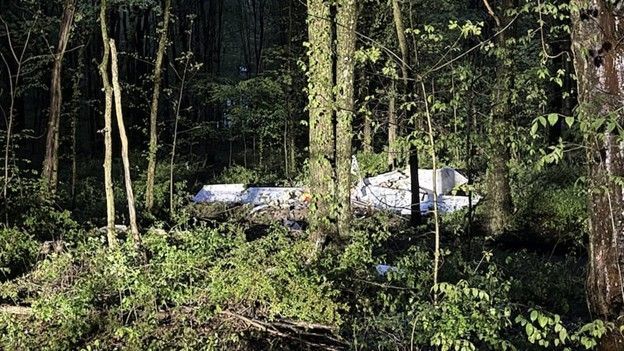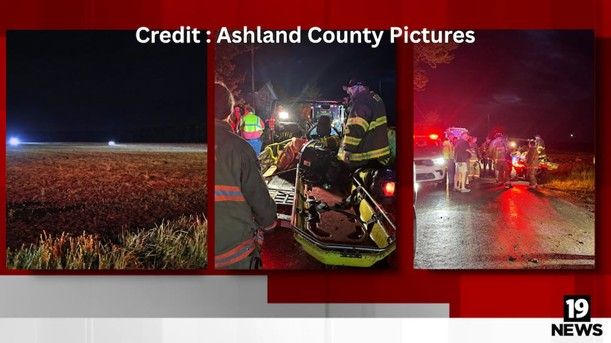ARFF Daily News
Published on:
Tuesday the 6th of May, 2025
72-year-old pilot dies in Ashland County plane crash
By Brian Koster and Julia Bingel
ASHLAND COUNTY, Ohio (WOIO) - A 72-year-old man died Monday evening after crashing his single-engine plane in Jackson Township.
The crash happened at 7:42 p.m. in a wooded area near State Route 89 and Township Road 902.
Ohio State Highway Patrol (OSHP) troopers said the pilot was the only person on board the Express 2000 FT.
He has been identified as Gary Wolfelt, of West Lafayette, Indiana.
Troopers said the crash remains under investigation.
Ashland County Sheriff deputies, Polk Jackson Perry Firefighters, an official from the Ashland County Coroner’s office, and representatives from the Federal Aviation Administration (FAA), and the National Transportation Safety Board (NTSB) also responded to the crash scene.
OSHP couldn’t determine if weather was a factor, but there were thunderstorms in Northeast Ohio around the time of the crash.
https://www.fox19.com/2025/05/06/72-year-old-pilot-dies-ashland-county-plane-crash/


NTSB Prelim: Cessna 310Q
Pilots Observed N8242Q In A Nose Down Attitude Spinning Toward The Ground
Location: Midvale, OH Accident Number: ERA25FA163
Date & Time: April 1, 2025, 17:04 Local Registration: N8242Q
Aircraft: Cessna 310Q Injuries: 1 Fatal
Flight Conducted Under: Part 91: General aviation - Personal
On April 1, 2025, about 1704 eastern daylight time, a Cessna 310Q, N8242Q, was substantially damaged when it was involved in an accident near Midvale, Ohio. The pilot was fatally injured. The airplane was operated as a Title 14 Code of Federal Regulations Part 91 personal flight. The pilot’s family members stated that he had been practicing “360° maneuvers.” Preliminary Automatic Dependent Surveillance-Broadcast (ADS-B) data showed that the airplane departed about 1640 from Harry Clever Field Airport (PHD), New Philadelphia, Ohio, and made a series of 360° turns southeast of the airport.
Two pilots performing an instructional flight in the airport’s traffic pattern reported that the pilot of N8242Q announced over the Common Traffic Advisory Frequency (CTAF), that he was on a 5-mile final approach leg of the traffic pattern for runway 33. When the airplane was on about a 2-mile final approach, the pilot announced that he was breaking off the approach to the east. The instructional flight flew an extended left downwind leg of the traffic pattern to allow time for N8242Q to reenter the final approach leg, then reentered the downwind leg. Shortly after, the pilot of N8242Q announced that he was performing a “360” to enter the final approach. The pilots observed N8242Q in a nose down attitude spinning toward the ground.
They further stated that there were no emergency or distress calls announced over the CTAF prior to the accident. A witness located near the accident site reported that he observed a twin engine airplane in a steep bank right turn followed by a spiraling nosedive as it descended to the ground. The airplane’s main wreckage was located in a cultivated field about 3.6 miles southeast of PHD. Postaccident examination of the accident site revealed that the airplane impacted the
terrain in a nose low attitude and came to rest on a southwest heading. The fuselage and both wings were mostly consumed by a postimpact fire. All major structural components of the airplane were located at the accident site. Flight control continuity was established from the cockpit to all flight control surfaces. The left and right engines remained attached to their engine mounts and exhibited impact and thermal damage. Crankshaft continuity was established to the rear gears of both engines via hand rotation of their attached propellers.
Impact damage was noted to the aluminum three-bladed propellers. Leading-edge damage and chord-wise abrasion was noted to the propeller blades, and the propeller spinners exhibited torsional deformation.
The wreckage was retained for further examination.
FMI: www.ntsb.gov

Today in History
37 Years ago today: On 6 May 1988 Widerøes flight 710, a de Havilland Canada DHC-7, flew into a hillside while on approach to Brønnøysund Airport, Norway, killing all 36 occupants.
Date: Friday 6 May 1988
Time: 20:30
Type: de Havilland Canada DHC-7-102
Owner/operator: Widerøes Flyveselskap
Registration: LN-WFN
MSN: 28
Year of manufacture: 1980
Total airframe hrs: 16934 hours
Cycles: 32347 flights
Engine model: P&W Canada PT6A-50
Fatalities: Fatalities: 36 / Occupants: 36
Other fatalities: 0
Aircraft damage: Destroyed, written off
Category: Accident
Location: 8 km SW of Brønnøysund Airport (BNN) - Norway
Phase: Approach
Nature: Passenger - Scheduled
Departure airport: Namsos Airport (OSY/ENNM)
Destination airport: Brønnøysund Airport (BNN/ENBN)
Investigating agency: Flyhavarikommisjon
Confidence Rating: Accident investigation report completed and information captured
Narrative:
Widerøes flight 710, a de Havilland Canada DHC-7, flew into a hillside while on approach to Brønnøysund Airport, Norway, killing all 36 occupants.
Flight WF710 took off from Trondheim (TRD), Norway, at 19:23 local time on a domestic light to Namsos (OSY), Brønnøysund (BNN), Sandnessjøen (SSJ) and Bodø Airport (BOO).
The flight to Namsos was uneventful. The aircraft took off from Namsos at 20:07 and contacted Trondheim ACC six minutes later, stating that they were climbing from FL70 to FL90. At 20:20 the crew began their descent for Brønnøysund and switched frequencies to Brønnøysund AFIS.
Weather reported at Brønnøysund was: wind 220°/05 kts, visibility 9 km, 3/8 stratus at 600 feet and 6/8 at 1000 feet, temperature +6 C, QNH 1022 MB.
The crew executed a VOR/DME approach to Brønnøysund's runway 04, followed by a circle for landing on runway 22. The crew left the prescribed altitude 4 NM early. The aircraft descended until it flew into the Torghatten hillside at 560 feet.
A retired police officer reported in July 2013 that a passenger had taken a mobile phone on board. The police officer disembarked the plane at Namsos, a stop-over and reported that the passenger with the mobile phone was seated in the cockpits jump-seat.
After the accident, he reported this fact to the Joint Rescue Coordination Centre (JRCC). After reading the investigation report during the 25th anniversary of the accident, he noticed that there was no mention of the mobile phone.
NMT 450 network-based mobiles at the time were fitted with a 15-watt transmitter and a powerful battery which could lead to disruption in electronic equipment.
The Norwegian AIB conducted an investigation to determine if electronic interference from the mobile phone might have affected the flight instruments. The AIB concluded that there was no evidence to support the theory that there was any kind of interference.
The cause of the accident was that the last part of the approach was started about 4 NM too soon. The aircraft therefore flew below the safe terrain clearance altitude and crashed into rising terrain. The Board cannot indicate any certain reason why the approach started so early.

